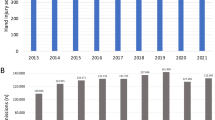Abstract
Background
Hand trauma is the most frequently treated injury in emergency departments, but presently there is a crisis of insufficient emergency coverage. This study evaluates the discrepancy of emergent and elective hand care trends based on socioeconomic factors in the state of Tennessee.
Methods
We identified 119 hospitals in Tennessee that contained operating and emergency room facilities. Of these, 111 hospitals participated in a survey to determine the availability of elective and emergency hand surgery. Wilcoxon rank-sum test or permutation chi-square test and logistic regression were used to analyze reported measures.
Results
Our results revealed that hospitals in counties with the lowest per capita income and median household income are less likely to have hand specialists or offer hand call. There are also significantly fewer hospitals that have hand specialists and offer hand call that are located in medically underserved areas. In the state of TN, level 1 trauma facilities are required by the Tennessee Department of Health to have staffed hand specialists and 24/7 hand call. Our study revealed that while 7/8 (87.5 %) level 1 trauma facilities have hand specialists, only 2/8 (25 %) provide 24/7 hand specialist call.
Conclusion
Our results strongly suggest the presence of a health care disparity for hand trauma in counties with a low income and in medically underserved areas.

Similar content being viewed by others
References
American Association of Medical Colleges. 2012. Available at https://www.aamc.org/. Accessed 4 Aug 2012.
American College of Emergency Physicians. On-Call Specialist Coverage in U.S. Emergency Departments. April 2006. Available at http://www.acep.org/pressroom.aspx?id=25262&ekmensel=c580fa7b_92_134_25262_4. Accessed 16 Aug 2012.
American Hospital Directory. 2012. Available at http://www.ahd.com/. Accessed 4 Aug 2012.
American Society for Surgery of the Hand. 2012. Available at http://www.assh.org/Public/About/Pages/Why.aspx. Accessed 23 Dec 2012.
Bureau of Labor Statistics. In: Nonfatal occupational injuries and illnesses requiring days away from work. 2010. http://www.bls.gov/news.release/osh2.nr0.htm. Accessed 5 Sept 2012.
Caffee H, Rudnick C. Access to hand surgery emergency care. Ann Plast Surg. 2007;58:207–8.
CDC. Nonfatal occupational injuries and illnesses treated in hospital emergency departments—United States, 1998. Morb Mortal Wkly Rep. 2001;50(16):313–17.
Center for Studying Health Systems Change. In: Hospital emergency on-call coverage: is there a doctor in the house? 2010. Available at http://www.hschange.com/CONTENT/956/956.pdf. Accessed 28 Aug 2012.
Health Resources and Services Administration. 2012. Available at http://www.hrsa.gov/index.html. Accessed 4 Aug 2012.
Melkun ET, Ford C, Brundage SI, et al. Demographic and financial analysis of EMTALA hand patient transfers. Hand (N Y). 2010;5:72–6.
Mueller M, Zaydfudim V, Sexton K, et al. Lack of emergency hand surgery: discrepancy between elective and emergency hand care. Ann Plast Surg. 2012;68(5):513–7.
Niska R, Bhuiya F, Xu J, National Hospital Ambulatory Medical Care Survey: 2007 Emergency Department Summary. National Health Statistics Reports. Number 26. 2010.
No authors listed. Survey: on-call surgical specialists hard to find; lack of incentives may be a root cause. ED Manag. 2011;23(5):57–9.
Rao MB, Lerro C, Gross CP. The shortage of on-call surgical specialist coverage. Academic Emergency Medicine. 2010;17:1374–82.
Soft Tissue Hand Injury Treatment & Management. 2011. Available at http://emedicine.medscape.com/article/826498-treatment#a1126. Accessed 16 Aug 2012.
Tennessee Department of Health Trauma Care Advisory Council. Trauma Care in Tennessee. A Report to the 2010 107th General Assembly. Nov. 8, 2010
Tennessee Department of Health. Rules of the Tennessee Department of Health Division of Health Care Facilities. Chapter 1200-8-12. Trauma Centers. Print. 2012
The American Board of Plastic Surgery, Inc. 2012. Certification and Recertification in the Subspecialty of Surgery of the Hand. 2011;11–13
U.S. Census Bureau. 2012. Available at http://www.census.gov/. Accessed 4 Aug 2012.
Werner SL, Plancher KD. Biomechanics of wrist injuries in sports. Clin Sports Med. 1998;17:407–20.
Acknowledgments
This work was supported by an institutional grant from Meharry Medical College and an institutional grant (VICTR) from Vanderbilt University Medical Center.
Conflict of Interest
The authors declare that they have no conflict of interest.
Author information
Authors and Affiliations
Corresponding author
About this article
Cite this article
Anthony, J.R., Poole, V.N., Sexton, K.W. et al. Tennessee emergency hand care distributions and disparities. HAND 8, 172–178 (2013). https://doi.org/10.1007/s11552-013-9503-z
Published:
Issue Date:
DOI: https://doi.org/10.1007/s11552-013-9503-z




